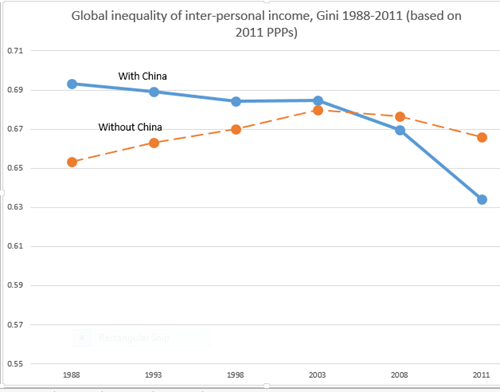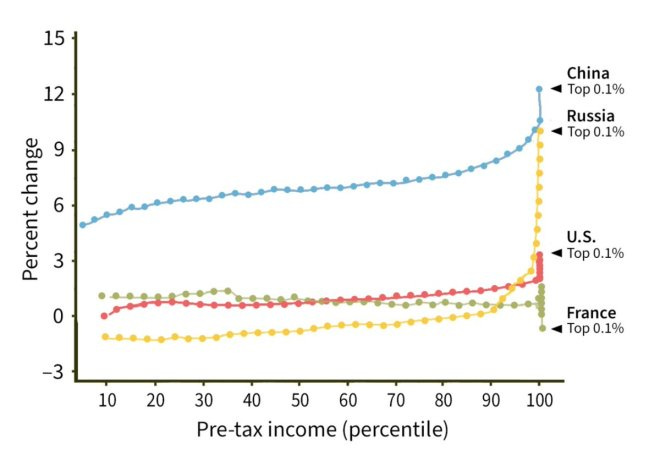Even higher than Kansas City, arguably
J. W. Mason is Associate Professor of Economics at John Jay College, City University of New York and a Fellow at the Roosevelt Institute
Originally published at Barron’s Cross-posted from J.W. Mason’s blog
Once upon a time, the promise of globalization seemed clear. In an economically integrated world, poor countries could follow the same path of development that the rich countries had in the past, leading to an equalization of global living standards. For mid-20th century liberals, restoring trade meant bringing the New Deal’s egalitarian model of economic development to a global stage. As Nebraska Senator Kenneth Wherry memorably put it, “With God’s help, we will lift Shanghai up and up, ever up, until it is just like Kansas City.”
For better and for worse, globalization has failed in its promise to deliver a planet of Kansas Cities. But Shanghai specifically is one place that it’s come through, and then some. As we debate the Biden administration’s new tariffs, let’s not lose sight of the fact that China’s industrialization is a very good thing for humanity. Indeed, it is the outstanding case of globalization’s promises being fulfilled.
For most of modern history, the gap between the global rich and global poor has only gotten wider. Though there are many tricky issues of measurement, most economic historians would agree with Branko Milanovic — perhaps the world’s foremost authority on the global distribution of income — that global inequality rose steadily for perhaps 200 years until 1980 or so. Since then, and particularly since 2000, there has been a sharp reversal of this trend; according to Milanovic, global income is probably more equally distributed today than at any time since the 19th century.
The reason for this remarkable turn toward equality? China.
According to Milanovic, the rise of China was almost singlehandedly responsible for the reduction in global inequality over the past 30 years. Thanks to its meteoric growth, the gap between the world’s rich and poor has closed substantially for the first time since the beginning of the Industrial Revolution.

Convergence to rich-country living standards is extremely rare historically. Prior to China, the only major examples in modern times were Taiwan and South Korea. Much more typical are countries like the Philippines or Brazil. Sixty years ago, according to the World Bank, their per-capita incomes were 6 and 14 percent that of the USA, respectively. Today, they are … 6 and 14 percent of the USA. There were ups and downs along the way, but overall no convergence at all. Other poor countries have actually lost ground.
Or as Paul Johnson summarizes the empirical growth literature: “Poor countries, unless something changes, are destined to remain poor.”
China is not just an outlier for how rapidly it has grown, but for how widely the benefits of growth have been shared. One recent study of Chinese income distribution over 1988-2018 found that while growth was fastest for the top, even the bottom 5 percent of wage earners saw real income grow by almost 5 percent annually. This is faster than any group in the US over that period. Milanovic comes to an even stronger conclusion: The bottom half of the Chinese income distribution saw faster growth than those at the top.

Thomas Piketty finds a similar pattern. “The key difference between China and the United States,” he writes, “is that in China the bottom 50 percent also benefited enormously from growth: the average income of the bottom 50 percent [increased] by more than five times in real terms between 1978 and 2015… In contrast, bottom 50 percent income growth in the US has been negative.”
It’s clear, too, that Chinese growth has translated into rising living standards in more tangible ways. In 1970, Chinese life expectancy was lower than Brazil or the Philippines; today it is almost ten years longer. As the sociologist Wang Feng observes in his new book China’s Age of Abundance, Chinese children entering school in 2002 were 5-6 centimeters taller than they had been just a decade earlier – testimony to vast improvements in diet and living conditions. These improvements were greatest in poor rural areas.
How has China delivered on the promises of globalization, where so many other countries have failed? One possible answer is that it has simply followed the path blazed by earlier industrializers, starting with the United States. Alexander Hamilton’s Report on Manufacturers laid out the playbook: protection for infant industries, public investment in infrastructure, adoption of foreign technology, cheap but strategically directed credit. The Hamiltonian formula was largely forgotten in the United States once it had done its work, but it was picked up in turn by Germany, Japan, Korea and now by China. As the Korean development economist Ha-Joon Chang puts it, insistence that developing countries immediately embrace free trade and financial openness amounts to “kicking away the ladder” that the rich countries previously climbed.
Today, of course, the US is rediscovering these old ideas about industrial policy. There’s nothing wrong with that. But there is something odd and unseemly about describing the same policies as devious manipulation when China uses them.
When John Podesta announced the formation of the administration’s White House Climate and Trade Task Force last month, he tried to draw a sharp line between industrial policy in the United States and industrial policy in China. We use “transparent, well-structured, targeted incentives,” he said, while they have “non-market policies … that have distorted the market.” Unlike us, they are trying to “dominate the global market,” and “creating an oversupply of green energy products.” Yet at the same time, the administration boasts that the incentives in the Inflation Reduction Act will double the growth of clean energy investment so that “US manufacturers can lead the global market in clean energy.”
No doubt if you squint hard enough, you can make out a distinction between changing market outcomes and distorting them, or between leading the global market and dominating it. But it certainly seems like the difference is when we do it versus when they do.
The claim that China is creating a global “overcapacity” in green energy markets — often trotted out by tariff supporters — is particularly puzzling. Obviously, to the extent that there is global overcapacity in these markets, US investment contributes exactly as much as Chinese does — that is what the word “global” means.
More importantly, as many critics have pointed out, the world needs vastly more investment in all kinds of green technologies. It’s hard to imagine any context outside of the US-China trade war where Biden supporters would argue that the world is building too many solar panels and wind turbines, or converting too quickly to electric vehicles.
Not so long ago, the dominant view on the economics of climate change was that the problem was the “free rider” dynamic — the whole world benefits from reduced emissions, while the costs are borne only by the countries that reduce them. In the absence of a global government that can impose decarbonization on the whole world, the pursuit of national advantage through green investment may be the only way the free rider problem gets solved.
As development economist Dani Rodrik puts it: “Green industrial policies are doubly beneficial – both to stimulate the necessary technological learning and to substitute for carbon pricing. Western commentators who trot out scare words like ‘excess capacity,’ ‘subsidy wars,’ and ‘China trade shock 2.0’ have gotten things exactly backwards. A glut in renewables and green products is precisely what the climate doctor ordered.”
The Biden administration is not wrong to want to support US manufacturers. The best answer to subsidies for green industries in China is subsidies for green industries in the US (and in Europe and elsewhere). In a world that is desperately struggling to head off catastrophic climate change, a subsidy race could harness international rivalry as a part of the solution. But that requires that competition be channeled in a positive-sum way.
Unfortunately, the Biden Administration seems to be choosing the path of confrontation instead. In the 1980s, the Reagan administration dealt with the wave of imported cars that threatened US automakers through a voluntary agreement with Japan to moderately reduce auto exports to the US, while encouraging investment here by Japanese automakers. Unlike the pragmatists around Reagan, the Biden team seems more inclined to belligerence. There’s no sign they even tried to negotiate an agreement, instead choosing unilateral action and framing China as an enemy rather than a potential partner.
Tellingly, National Security Advisor Jake Sullivan is described (in Alexander Ward’s new book The Internationalists) as arguing that the US can make serious climate deals with other countries while “boxing China out,” a view that seems to have won out over the more conciliatory position of advisors like John Kerry. If Sullivan’s position is being described accurately, it’s hard to exaggerate how unrealistic and irresponsible it is. The US and China are by far the world’s two largest economies, not to mention its preeminent military powers. If their governments cannot find a way to cooperate, there is no hope of a serious solution to climate change, or to other urgent global problems.
To be clear, there’s nothing wrong with an American administration putting the needs of the United States first. And if it’s a mistake to treat China as an enemy, it would also be wrong to set them up as an ideal. One could make a long list of ways in which the current government of China falls short of liberal and democratic ideals. Still, it’s clear that China is being punished for its economic success rather than its political failures. Tellingly, the same month that the tariffs on China were announced, the Biden administration indicated that it would resume sales of offensive weapons to Saudi Arabia, whose government has nothing to learn from China about political repression or violence against dissidents.
The policy issues around tariffs are complicated. But let’s not lose sight of the big picture. The fundamental premises of globalization remain compelling today, even if attempts to realize them have often failed. First, no country is an island – today, especially, our most urgent problems can only be solved with cooperation across borders. Second, economic growth is not a zero sum game – there is not some fixed quantity of resources, or markets, available, so that one country’s gain must be another’s loss. And third, democracy spreads best via example and the free movement of ideas and people, not through conquest or coercion. We don’t have to endorse the whole classical case for free trade to agree that its proponents were right in some important ways.
China’s growth has been the clearest case yet of globalization’s promise that international trade can speed the convergence of poor countries with rich ones. The opportunity is still there for its broader promises to be fulfilled as well. But for that to happen, we in the rich countries must accept that if the rest of the world catches up with us, that is something to be welcomed rather than feared.



Be the first to comment